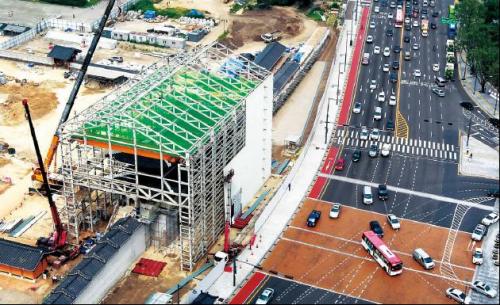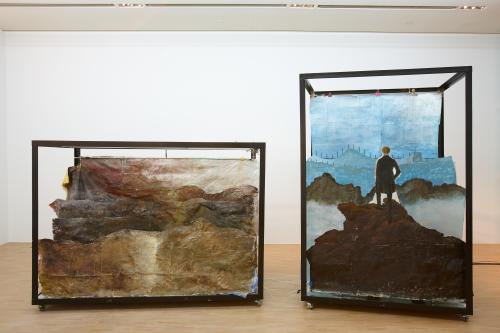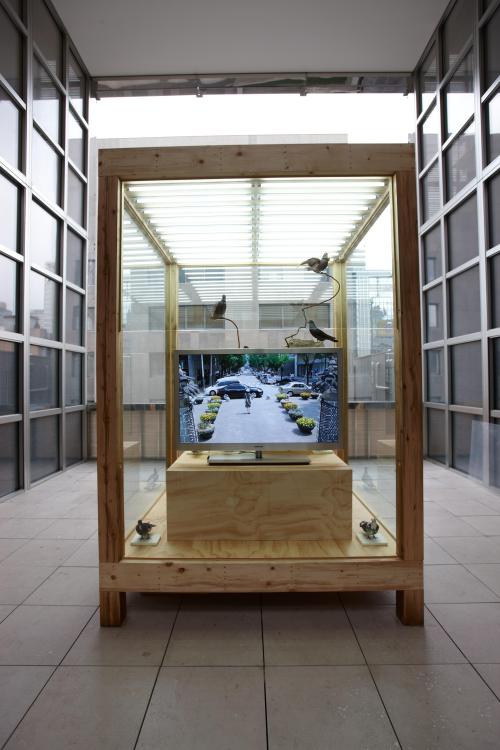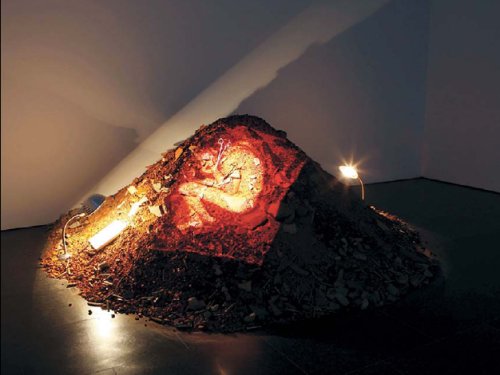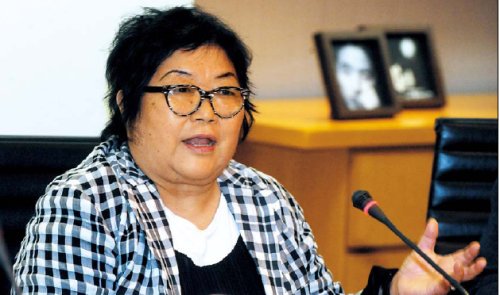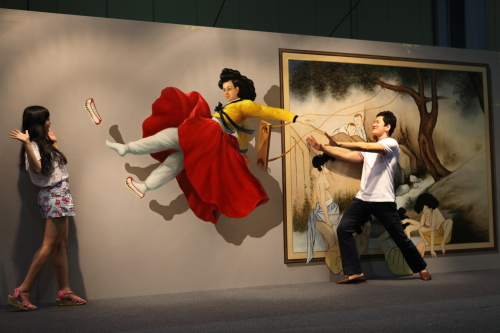A discussion between six middle-aged architects over the final details about the Korean pavilion was heating up Atelier 17, Kwon moon-sung’s architect office in Yangjae-dong, southern Seoul.
Kwon, commissioner of the Korean pavilion for this year’s Venice Biennale International Architecture Exhibition, and the five architects -- Cho Jung-goo, Lee Sang-koo, Lee Chung-kee, Shin Seung-soo, Hah Tesoc -- who will be representing the nation in Venice from August to November, have been holding more than 50 meetings like this during the past five months.
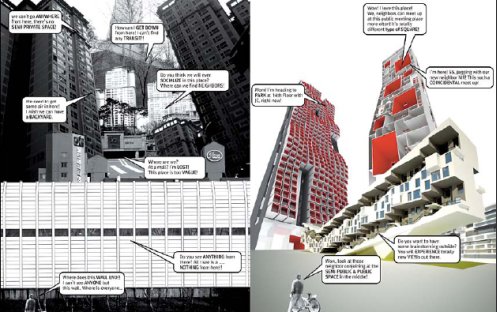 |
| “Barcity vs citybar” by Shin Seung-soo Shin Seung-soo |
“The biennale is just one month away. Now is the busiest time. We usually hold meetings late at night around 10 p.m. because we all have to be at our jobs in the daytime. Today’s an exception,” Kwon told The Korea Herald.
Founded in 1980, Venice Biennale is one of world’s three major biennales along with the Sao Paulo Biennale and Whitney Biennale. The art exposition takes place on odd-numbered years, while the architecture exhibition takes place in the even-numbered years.
Korea and Japan are the only two Asian countries among 25 nations around the world that have their own pavilion at the prestigious architecture festival. This year is the seventh time that Korea is participating in the biennale. Led by director Kazuyo Sejim, the 12th biennale is to be held under the theme “People meet in architecture” from Aug. 29 to Nov. 21 at Castello Gardens and Arsenale in Venice, Italy.
Kwon chose the theme “Re-place-ing, Documentary of Changing Metropolis Seoul” for the Korean pavilion.
“We picked a theme that is familiar to Koreans but could pique the curiosities of foreigners. It is an interesting procedure how Seoul changed its look as it went through rapid economic growth, a concentrated population, the Korean War and more. The exhibition will particularly focus on the historical meanings, influences and the future of apartment houses and public spaces,” said Kwon.
The Korean pavilion will be in a form of a “Hanok,” or traditional Korean-style house, because the experts agreed that it is probably the original form of Korean-style architecture. Kwon said that he also hopes the place will act as a resting place for the Biennale visitors.
 |
| The Korean pavilion will be set up like a Hanok that visitors can take a rest in. Cho Jung-goo |
“The Korean pavilion is placed at the end of the Biennale venue. So if visitors circle around the place, our pavilion will be at the mid-point. We hope the visitors can meet in the Korean pavilion,’” said Kwon.
An important task was to make the works by five architects to blend together and appear like something created by a single person or team. After numerous discussions, the architects came up with an organized format divided into three big sections, with each representing Seoul’s past, present and future. Each participant sat down to share their thoughts and introduce their works to The Korea Herald.
Section A -- “Seoul’s past” by Cho Jung-goo and Lee Sang-koo
Cho: People think Seoul is changing too quickly, leaving no original traces, but I know that the older parts of Seoul are still vividly present. It is important that we rediscover the values and treasure them as we develop the city.
 |
(From left) Kwon moon-sung, Shin Seung-soo, Lee Sang-koo, Cho Jung-goo, Hah
Tesoc and Lee Chung-kee discuss the final details of the Korean pavilion.
Lee Sang-sub/The Korea Herald |
I sought to be very meticulous in depicting the streets, alleys and buildings of the areas near the Gyeongbok Palace in Seoul, including Naesu-dong, Naeja-dong and Hyoja-dong, into a six meter wide and 3.8 meter-long pen drawing. It appears like a view you’ll see when you are flying.
One of the alleys is made into a miniature model, complete with tiny houses and yards. I wanted to show that the history of our city and the traces of our lives are still alive.
Lee: Cities are supposed to be made by the people who actually live there. But ever since the start of the 20th century, we started to live in cities that somebody else designed. I was, therefore, moved to look into cities that its own residents had created. It is important that we learn from what we already have.
Cho: It is also my job to turn the Korean pavilion into a Hanok. I am taking the wood from an actual Hanok that used to be in Hyehwa-dong and modifying the sizes a little bit. It will not be a full Hanok complete with a tiled roof, but you will be able to see the architectural essence from the wooden structures.
It is not only an effort to show the value of Hanok as a living space but also to show the ironical situation of Seoul, where some places like the Bukchon village well preserves the Hanok but other places virtually destroy the Hanok in the name of redevelopment.
Section B -- “Seoul’s present” by Lee Chung-kee and Shin Seung-soo
Lee: Section B aims to show how many parts of the city, which is several hundred years old, is getting erased and replaced in a flash. Seoul is a city of apartments. We will be exhibiting every possible research result and historical document about apartments in the nation’s capital.
One of them is a digital map depicting the number of apartment buildings. Because the dark circles represent the congested areas, the finished map turned out to look like Swiss cheese.
We will also display photos of apartment buildings along the Han River, which plainly reveal how they are blocking the mountains and the river. I am not trying to say that it is bad or good. It is just to show the facts.
Some interesting research results will be exhibited as well, like how long or high it will be when all apartments of the city are lined up or sideways.
Shin: Based on our research, when all of Korea’s apartments are lined sideways, it can go around the earth three times.
Lee: Or it can cover the whole city of Seoul.
Shin: I subtitled my part of the exhibition ‘space bar.’ Like how the space bar on the keyboard makes spaces between words so that the following word can be written down, public places provide spaces between apartments to enable the next apartment to be placed nearby.
Public places contain memories and conversations between people filling up the space. Considering the main theme of the biennale, “People meet in architecture,” I expressed how people meet at and use public spaces, using cartoons.
Our living spaces are pretty much blocked from others by retaining and soundproofing walls. This cartoon will be like a mini scenario about how we can get the fragmented individuals to communicate with each other and about the relationship between apartments, public places and external spaces.
Section C -- “Seoul’s future” by Hah Tesoc
Hah: The problem with today’s apartment buildings is that consumers have only one way, a very passive way, of getting an apartment -- moving into one that is ready-made by some architect. And there are only two or three models.
Because everyone lives in such a standardized space, the whole city seemed to be somehow shut up in anonymity.
So I am proposing a way that enables everyone to create their own apartments that perfectly fit into each of their lifestyles. This way, the city can exude a unique identity.
One can simply download the smartphone application I made for the phone and input it as one’s source for lifestyle information. Just the right type of neighbors and apartment units that perfectly match the user’s lifestyle will be suggested. As more information is collected, cities with different identities can be created.
A beam projector will shoot this whole city-building process onto all of the six walls in section C, turning the space into a virtual apartment. Visitors can participate with the smartphones equipped at the venue or at home with their smartphones.
By Park Min-young (claire@heraldm.com)
